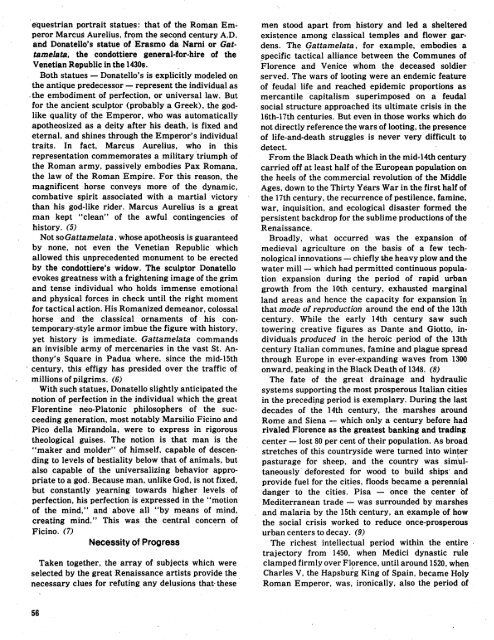Renaissance and
Renaissance and
Renaissance and
You also want an ePaper? Increase the reach of your titles
YUMPU automatically turns print PDFs into web optimized ePapers that Google loves.
equestrian portrait statues: that of the Roman Era- men stood apart from history <strong>and</strong> led a sheltered<br />
peror Marcus Aurelius, from the second century A.D. existence among Classical temples <strong>and</strong> flower gar<strong>and</strong><br />
Donatello's statue of Erasmo da Narni or Gat- dens. The Gattamelata, for example, embodies a<br />
tameIam, the condottiere general-for-hire of the specific tactical alliance between the Communes of<br />
Venetian Republicinthe1430s. Florence <strong>and</strong> Venice whom the deceased soldier<br />
Both statues -- Donatello's is explicitly modeled on served. The wars of looting were an endemic feature<br />
the antique predecessor- represent the individual as of feudal life <strong>and</strong> reached epidemic proportions as<br />
,the embodiment of perfection, or universal law. But mercantile capitalism superimposed on a feudal<br />
for the ancient sculptor (probably a Greek), the god- social structure approached its ultimate crisis in the<br />
like quality of the Emperor, who was automatically 16th-17th centuries. But even in those works which do<br />
apotheosized as a deity after his death, is fixed <strong>and</strong> not directly reference the wars of looting, the presence<br />
eternal, <strong>and</strong> shines through the Emperor's individual of life-<strong>and</strong>-death struggles is never very difficult tO<br />
traits. In fact, Marcus Aurelius, who in this detect.<br />
representation commemorates a military'triumph of From the Black Death which in the mid-14th century<br />
the Roman army, passively embodies Pax Romana, carried off at least half of the European population on<br />
the law of the Roman Empire. For this reason, the the heels of the commercial revolution of the Middle<br />
magnificent horse conveys more of the dynamic, Ages, down to the Thirty Years War in the first half of<br />
combative spirit associated with a martial victory the 17th century, the recurrence of pestilence, famine,<br />
than his god-like rider. Marcus Aurelius is a great war, inquisition, <strong>and</strong> ecological disaster formed the<br />
man kept "clean" of the awful contingencies of persistent backdrop for the sublime productions of the<br />
history. (5) <strong>Renaissance</strong>.<br />
Not soGattamelata,whoseapotheosisisguaranteed Broadly, what occurred was the expansion of<br />
by none, not even the Venetian Republic which medieval agriculture on the basis of a few techallowed<br />
this unprecedented monument to be erected nological innovations -- chiefly the heavy plow <strong>and</strong> the<br />
by the condottiere's widow. The sculptor Donatello water mill -- which had permitted continuous populaevokes<br />
greatness with a frightening image of the grim tion expansion during the period of rapid Urban<br />
<strong>and</strong> tense individual who holds immense emotional growth from the 10th century, exhausted marginal<br />
<strong>and</strong> physical forces in check until the right moment l<strong>and</strong> areas <strong>and</strong> hence the capacity for expansion in<br />
for tactical action. His Romanized demeanor, colossal that mode of reproduction around the end of the 13th<br />
horse <strong>and</strong> the classical ornaments of his con- century. While the early 14th century saw such<br />
temporary-style armor imbue the figure with history, towering creative figures as Dante <strong>and</strong> Giotto, inyet<br />
history is immediate. Gattamelata comm<strong>and</strong>s dividuals produced in the heroic period of the 13th<br />
an invisible army of mercenaries in the vast St. An- Century Italian communes, famine <strong>and</strong> plague spread<br />
thony's Square in Padua where, since the mid-15th through Europe in ever-exp<strong>and</strong>ing waves from 1300<br />
' century, this effigy has presided over the traffic of onward, peaking inthe Black Death of 1348. (8)<br />
- millions of pilgrims. (6) The fate of the great drainage <strong>and</strong> hydraulic<br />
With such statues, Donatello slightly anticipated the systems supporting the most prosperous Italian cities<br />
notion of Perfection in the individual which the great in the preceding period is exemplary. During the last<br />
Florentine neo-Platonic philosophers of the suc- decades of the 14th century, the marshes around<br />
ceeding generation, most notably Marsilio Ficino <strong>and</strong> Rome <strong>and</strong> Siena -- which only a century before had<br />
Pico della Mir<strong>and</strong>ola, were to express in rigorous rivaled Florence as the greatest banking <strong>and</strong> trading<br />
theological guises. The notion is that man is the center -- lost 80 per cent of their population. As broad<br />
"maker <strong>and</strong> molder" of himself, capable of descen- stretches of this countryside were turned into winter<br />
ding to levels of bestiality below that of animals, but pasturage for sheep, <strong>and</strong> the country was simUlalso<br />
capable of the universalizing behavior appro- taneously _deforested for wood to build ships' <strong>and</strong><br />
priate to a god. Because man, unlike God, is not fixed, provide fuel for the cities, floods became a perennial<br />
but constantly yearning towards higher levels of danger to the cities. Pisa -- once the center of<br />
perfection, his perfection is expressed in the "motion Mediterranean trade -- was surrounded by marshes<br />
of the mind," <strong>and</strong> above all "by means of mind, <strong>and</strong> malaria by the 15th century, an example of how<br />
creating mind." This was the central concern of the social crisis worked to reduce once-prosperous<br />
Ficino. (7) urban centers to decay. (9)<br />
Necessity of Progress The richest intellectual period within the entire<br />
trajectory from 1450, when Medici dynastic rule<br />
Taken together, the array of subjects whicl_ were Clamped firmly over Florence, until around 1520, when<br />
)<br />
selected by the great <strong>Renaissance</strong> artists provide the Charles V, the Hapsburg King of Spain, became Holy<br />
necessary clues for refuting any delusions that-these _ Roman Emperor, was, ironically, also the period of<br />
56

















